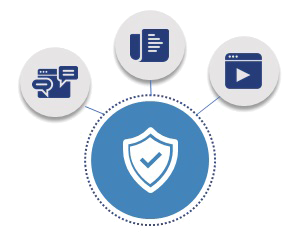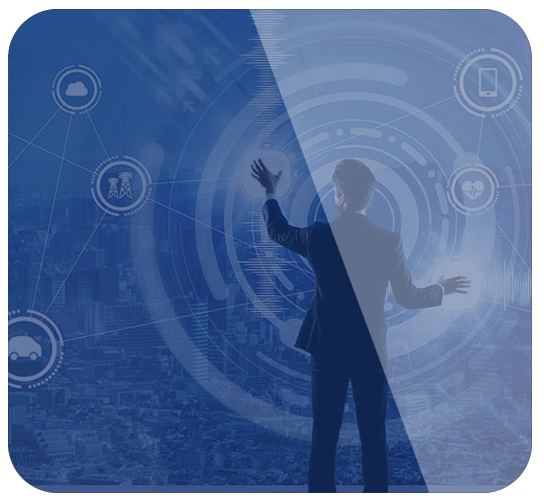Top Cybersecurity Tips for Businesses 2022
Written October 5, 2022

Data breaches have been on the rise for some years, and 2022 has unfortunately been strewn with cyber thefts of critical information. Attackers have targeted firms and organizations of all shapes, sizes, and industries this year, and they're costing corporations millions of dollars in damages. Large enterprises attract a diverse spectrum of hostile actors and rogue governments due to their sheer size and volume of sensitive data. According to a recent Ponemon Institute report, the average data breach cost in 2022 will be $4.35 million, a 2.6% increase from the amount in 2021 of $4.24 million.
All organizations are vulnerable to cyber threats and bad actors making it important to practice good security hygiene and to continue improving their cybersecurity posture. This article provides eight cybersecurity tips that organizations can leverage to improve their cyber security.
Common Cyber Attacks
Currently, businesses are exposed to an infinite number of cyber-attacks from locations all over the globe. Everything from highly sophisticated advanced persistent threats (APTs) to script kiddies searching for an easy mark to exploit. Organizations should be prepared for a number of assaults that have grown commonplace and are targeted by both inexperienced and seasoned cybercriminals. Here is five of the most typical ways that companies are attacked today:
Ransomware: The first, which has infiltrated the mainstream culture is Ransomware. There are a variety of forms that ransomware may take, but they are all based on the same fundamental principle - you will not be able to access your data unless you pay the demanded sum. Attackers will frequently demand a second ransom payment after the initial one in order to prevent stolen data from being sold on the internet.
Third Party Risk: More sophisticated attackers will try to utilize a third party linked with the targeted company in order to get access to a system, rather than directly attacking the organization itself. The SolarWinds breach in 2020 was one of the most recent events. Over 30,000 organizations and government agencies across the world trust SolarWinds Orion to keep their networks running smoothly. SolarWinds had a security flaw that allowed the delivery of a backdoor virus to thousands of businesses, leaving many of them vulnerable to cyberattack.
Social Engineering: The goal of social engineering is to get a person to reveal confidential information rather than a computer system. Email phishing is a common attack strategy in which the target is tricked into downloading malicious software or providing personal information. Oftentimes, social engineering is the first step of a multi-step cyberattack. An organization's security measures can be rendered ineffective if, for example, the CEO or System Administrator is breached.
Compromised Credentials: An attacker is "credential stuffing" when they utilize compromised credentials from one company to gain access to another company's user accounts. Credentials like this are often obtained through a data breach or purchased on the dark web. You may have read that some Disney Plus accounts were compromised, but Disney says there's no proof that any accounts were ever broken into. This is due to the fact that a credential stuffer just needs the victim's login and password to get access to the account.
Poor Patching Cadence: When security parameters aren't clearly established and put into practice, or when the default values are kept, vulnerabilities appear. Typically, this indicates that the settings are not up to par with CIS Benchmarks or OWASP Top 10. Because of how simple they are to see, misconfigurations are frequently targeted by hackers.
It's not uncommon for misconfigurations to involve far more than just an errant firewall rule. Unpatched systems, failed access control, exposed critical data, and obsolete components are only some of the most typical examples of misconfigurations. Similar to how you can hire a penetration testing firm to check for these openings in your network defenses, attackers may buy tools on dark web marketplaces to perform the same thing.
8 Ways to Prevent Cyber Attacks
Although it may appear like assaults take place overnight, the majority of the time it takes days, if not weeks or even months, for the attacks to be identified. In response, bringing attention to one of the most significant obstacles that businesses confront regarding cybersecurity, namely the lack of knowledge and accessible resources to protect themselves against threat actors. To assist organizations in overcoming these problems, we have compiled a list of eight cybersecurity tips which organizations can use while improving their cybersecurity and protecting their organization.
Engage an Experienced Third Party: Most of the tasks on this list can be accomplished by your own staff, but it's smart to bring in an outside expert to help you strengthen your overall cybersecurity posture. An outsider with extensive knowledge in the field is in the ideal position to provide impartial guidance on how to make the most of your time and energy.
Prevent Email Phishing: A common method of spreading malware in organizations is through phishing email. To protect against ransomware and avoid financial loss, it is crucial to educate your personnel on how to recognize and avoid these assaults. Spam and harmful emails may be more easily identified and blocked from entering an organization using a combination of education and technology. As part of establishing a solid foundation for security, it is crucial to set up SPF, DMARC, and DKIM records correctly.
Mature Patching Cadence: Finding the right time to patch and upgrade systems has gotten more challenging as uptime has become an increasingly essential factor in determining whether or not a business will remain competitive. However, in order to prevent a possible disaster, it is essential that your company set up a mature patching cycle for all of the systems that are part of the environment. The vast majority of consumers are aware that regular maintenance is necessary, provided that they are kept informed and are adequately prepared.
Implement Multi Factor Authentication: When a person attempts to log into a system that uses multifactor authentication (MFA), that user will be required to utilize a second authentication method. The implementation of MFA into your company will offer a significantly higher degree of security and provide protection against a wide variety of attacks, including several of the ones described above. Duo and Okta are two famous examples of such solutions.
User Education: An uneducated user is all it takes to defeat even the most stringent security measures. Users absolutely must participate in ongoing computer security training to be informed about emerging threats and defense strategies. By keeping users informed, they will be able to report anything that seems out of the ordinary to the company, which will, in turn, provide the organization the opportunity to halt a hostile actor before they have a chance to establish a foothold in the environment.
Establish Vendor Risk Management: Guaranteeing safety from the unknowable is challenging yet doable. Companies frequently grant vendors access to restricted sections of the company without gaining much information about the vendor's security procedures. Collaborate with your suppliers by conducting yearly risk assessments and investigating the vendor's security policies and practices. A number of third-party tools exist to aid in fully automating this procedure.
Backing Up Data: The importance of backing up your data cannot be overstated. It's not enough to just make copies of your data; you must also test your backups regularly. If your backup fails or becomes damaged at a crucial time, such as a natural disaster, you will be in a world of hurt.
Leverage a Good Antivirus System: Antivirus software varies greatly in quality. Find the best answer for your company by giving it some time and thought. Make sure a dashboard is accessible from a central location, and set aside the funds to have someone within or externally keep an eye on it.
In addition to following sound security procedures and receiving appropriate training, it may be beneficial to make use of the aid of third-party software and solutions to provide additional layers of data security. For instance, it is recommended to make use of a top-tier antivirus service to further protect your website and keep an eye out for any potential dangers. Additionally, a virtual private network (VPN) should be utilized to maintain your online privacy.
Want to Learn More
KeyData's primary offerings are related to identity and access management (IAM) and cyber security. Our expertise lies on enhancing the cybersecurity of existing institutions. To that end, we focus all of our efforts on ensuring the safety of businesses. KeyData's competitive advantage comes from its knowledgeable and hardworking staff. Our company is made up of expert engineers and consultants that work in the fields of cybersecurity implementation, privileged access management, customer identity and access management, and cloud security posture management. From needs analysis and road mapping to complete implementation, training, and managed support, our team has a proven track record in offering comprehensive IAM and Cybersecurity services. If you're interested in scheduling a no-cost initial consultation, please don't delay in contacting us.
References:
- https://www.fcc.gov/communications-business-opportunities/cybersecurity-small-businesses
- https://www.fortinet.com/resources/cyberglossary/10-cybersecurity-tips-small-business
- https://www.titanfile.com/blog/cyber-security-tips-best-practices/
- Cost of Cyber Attacks On Business in 2022 | Ascendant (ascendantusa.com)
- SolarWinds hack explained: Everything you need to know (techtarget.com)
- Most Common Cyber Security Threats In 2022 – Forbes Advisor
- What is the Cost of a Data Breach in 2022? | UpGuard
- 21 Cybersecurity Tips and Best Practices for Your Business [Infographic] - TitanFile
- 10 Ultimate Cybersecurity Tips for Small Businesses | Fortinet
- Cybersecurity for Small Businesses | Federal Communications Commission (fcc.gov)





